Acne Scar & Acne Treatment for Asian Skin
Acne is one of the most common skin conditions worldwide, and it is estimated that one in every five people with acne will develop scars. There are many treatments available to target blemishes and reduce scarring, including chemical peels, laser procedures, specialized skincare products, and other options. To achieve the best results and minimize side effects, your rejuvenation plan should be customized to your specific skin type and tone. For optimal acne and scar improvement, it is highly recommended to consult with an experienced, board-certified dermatologist like Dr. Michele Green in NYC. With over 25 years of experience treating patients of all skin types and tones, Dr. Green will tailor your treatment plan to help you achieve smooth, clear, and healthy skin safely and effectively.
Asian skin is particularly sensitive compared to other skin types, which means that some traditional acne treatments may be too harsh for it. Additionally, Asian skin is more prone to post-inflammatory hyperpigmentation (PIH), a condition characterized by dark spots resulting from increased melanin production during the healing process. In Asian skin, PIH can result from an acne breakout or as a side effect of certain acne and scar treatments. That’s why working with a skilled, board-certified dermatologist who knows what is safe and effective for your skin type is crucial. When you consult with Dr. Green, she will work with you to create a personalized acne treatment plan that includes specialized skincare products, necessary topical and oral medications, and in-office procedures tailored to your skin tone and type.
Dr. Michele Green is an internationally recognized, board-certified dermatologist with over 25 years of experience providing exceptional treatment options to some of the world’s most discerning individuals, including those with acne breakouts and scars. She is consistently ranked as one of New York City’s top dermatologists by Castle Connolly, New York Magazine, Super Doctors, and The New York Times for her commitment to her patients and expertise in the field. Dr. Green takes a holistic approach, following a less-is-more philosophy, and tailors each patient’s acne and scar treatment plan to include a combination of in-office procedures, oral and topical medications, and specially formulated skincare products designed to meet their unique needs. When you see Dr. Green at her private dermatology practice in Manhattan’s Upper East Side, she will collaborate with you to create a personalized treatment plan that best matches your skin type, specific concerns, skin tone, and overall aesthetic goals.
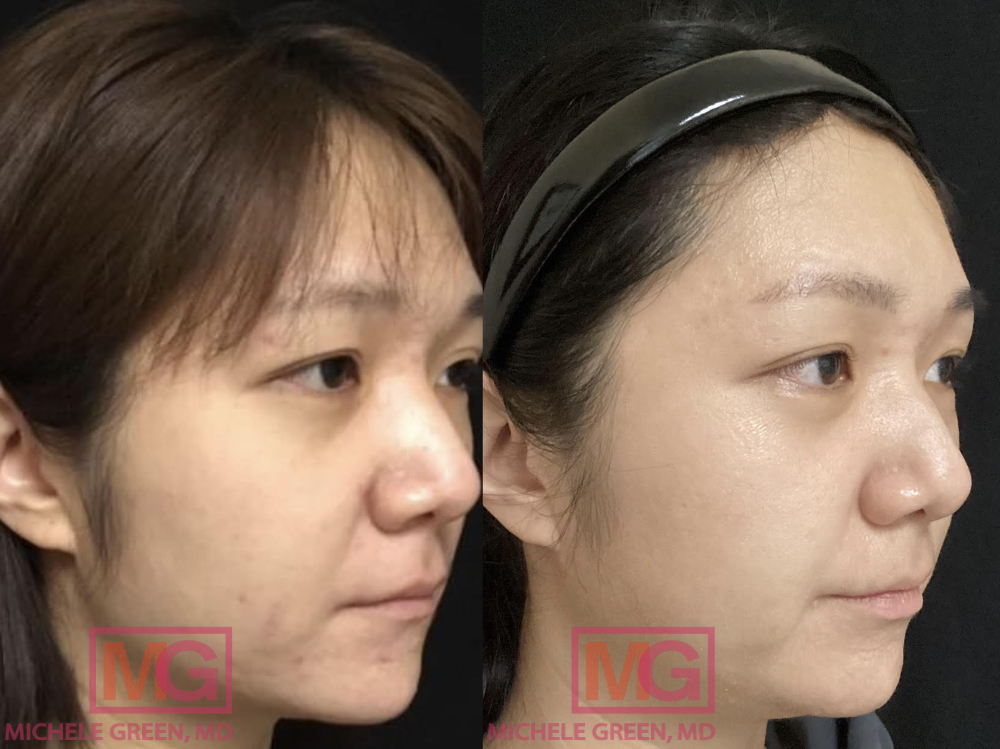
Do Asians get acne?
Yes, Asians can and do get acne. Acne vulgaris, commonly referred to as acne, is one of the most prevalent skin conditions, affecting millions of people of all skin types and tones worldwide. Characterized by blemishes and pimples on the skin’s surface, acne breakouts can happen at any age, even beyond adolescence. Hormonal changes, excess oil production, and poor skincare routines can clog pores and lead to acne breakouts, which might develop into inflammatory acne and scars if left untreated. Inflammatory acne occurs when bacteria clog pores, damaging the skin and slowing the healing process, which can result in scarring. Luckily, many acne and scar treatments are safe and effective for all skin types, including Asian skin.
Since acne scars are often more difficult to treat than the acne itself, it’s essential to address breakouts promptly. Depending on the type and severity of acne, Dr. Green might recommend in-office procedures, oral or topical medications, or specific skincare products. Typically, a combination of treatments is most effective for patients with multiple types of acne. Once the acne is under control, Dr. Green can use various laser therapies, chemical peels, microneedling, and targeted skincare to reduce the appearance of scars and residual pigmentation.
Because Asian skin has higher melanin levels, there is a greater risk of post-inflammatory hyperpigmentation, which can cause dark spots after certain treatments. These include laser procedures, such as intense pulsed light (IPL), as well as some exfoliants and topical creams. When considering acne and acne scar treatments for Asian skin, the most important step is to find a dermatologist experienced in treating all skin tones, like Dr. Michele Green in NYC. With over 25 years of experience treating patients of all skin types and tones, she can develop a personalized acne and scar treatment plan that leaves you with clear, smooth, radiant skin.
What are the types of acne blemishes?
Acne patients can develop various types of blemishes, including whiteheads, blackheads, papules, pustules, nodules, and cysts. Whiteheads and blackheads are non-inflammatory forms of acne, commonly referred to as comedones. Whiteheads are closed comedones that look like white or skin-colored bumps on the skin’s surface, caused when pores or hair follicles are blocked with oil and sebum, with the follicle remaining closed. Blackheads, on the other hand, are open comedones that appear black because of the reaction between the clogged pore contents and air.
When clogged pores become inflamed, they may show as papules, which are small, tender, pink bumps without pus, or pustules, which contain pus and look yellow or white. When bacteria are trapped in the pores, nodules or cysts can form, usually the most painful type of acne, and the most likely to leave scars. Nodules develop deep within the skin, resulting in painful bumps on the surface. Cysts also form deep under the skin but are filled with pus. Recognizing your specific type of acne is key to finding an effective treatment plan.
Why do patients develop acne?
Acne happens when pores are clogged with dead skin cells, excess oil, dirt, and other impurities. Inflammatory acne can occur when bacteria get trapped inside the pores. Genetics significantly influence acne breakouts, as some individuals have more sebaceous glands or naturally produce more sebum. Hormonal shifts during puberty, menstruation, pregnancy, and menopause can also increase sebum production. Moreover, lifestyle habits such as diet, sleep, and hygiene can contribute to the development of acne. The best way to determine what’s causing your breakouts is to consult with an expert, such as Dr. Michele Green. During your visit, she will review your medical and family history, examine your skin, and may order blood tests for further assessment. She will then suggest a personalized combination of treatments and medications to help clear your skin and achieve a smooth, clear complexion.
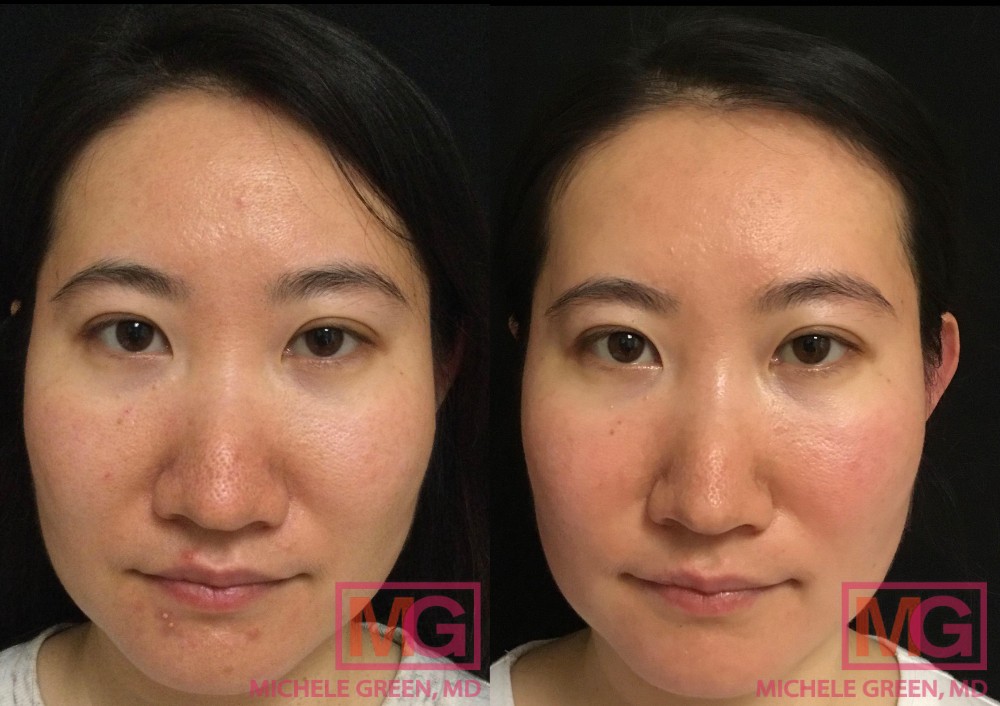
Is Asian skin more prone to acne?
Acne results from a buildup of sebum, dead skin cells, and other pore debris, which causes bumps and inflammation on the skin’s surface. Excess sebum production, also known as sebum, can increase the risk of developing acne vulgaris, as excessive sebum can clog the pores. Some research suggests that Asian skin may be more prone to oiliness than Caucasian skin, which can increase the likelihood of developing acne vulgaris.
How to get rid of acne in Asian skin
The best way to manage acne on Asian skin is to consult a board-certified dermatologist, such as Dr. Michele Green in New York City. Asian skin is particularly prone to developing post-inflammatory hyperpigmentation after an acne breakout, and treating breakouts promptly and effectively can help reduce scarring and hyperpigmentation later on. Dr. Green offers various options for acne treatment, tailoring each patient’s plan to their unique skin type, tone, and concerns to achieve clear, radiant skin.
Acne surgery
Acne Surgery is an in-office treatment for inflammatory acne lesions, such as cysts, papules, and pustules. During the procedure, Dr. Green opens the acne lesions and removes sebum, dead skin cells, dirt, and other impurities from within the pores. She then injects a steroid to decrease inflammation, shrink the lesion, speed up healing, and help prevent scarring. There is no downtime with acne surgery, making it a great option for reducing painful inflammatory lesions.
VBeam Laser for acne treatment
The VBeam Laser is a pulsed dye laser that targets acne breakouts and pigmented scars. It emits a 595nm wavelength to the skin to eliminate acne-causing bacteria, reduce redness, and decrease inflammation. In addition to treating acne and pigmented scars, the VBeam can also address post-inflammatory hyperpigmentation, rosacea, facial redness, broken capillaries, and red or purple stretch marks. No downtime is required during treatment, and multiple sessions, spaced approximately one month apart, are recommended for optimal results.
HydraFacial to treat acne-prone skin
A HydraFacial is a specialized facial treatment designed to cleanse, exfoliate, and nourish the skin. HydraFacials utilize patented vortex technology that acts like a vacuum to remove impurities and deliver ingredients deeply into the pores. The first step involves gently cleansing the skin of dead skin cells, sebum, dirt, and other impurities from the surface. The second step applies a glycolic and salicylic acid serum to help extract impurities from clogged pores. The final step delivers key peptides and proteins to hydrate and nourish the skin. A HydraFacial can be customized with various booster serums to target different skin concerns, including acne, hyperpigmentation, aging, and rosacea. The Murad Clarifying Booster is an excellent option for patients experiencing acne, as it contains salicylic acid to exfoliate and green tea extract to reduce inflammation. During treatment, LED light can also be used—red LED light reduces inflammation and redness, while blue LED light kills acne-causing bacteria on the skin’s surface.
Chemical peels to treat acne breakouts
A chemical peel is an in-office topical treatment used to address various skin concerns, including acne, acne scars, fine lines, wrinkles, enlarged pores, hyperpigmentation, and uneven skin texture and tone. During the procedure, a chemical exfoliant is applied to the skin to enhance skin cell turnover, removing dead cells to reveal healthy, radiant skin underneath. Chemical peels are especially effective for treating acne, as they help exfoliate dead skin, dirt, debris, and other impurities trapped in the pores. They can be performed monthly to help control and reduce acne breakouts.
Oral antibiotics for acne-prone skin
Antibiotics like Doxycycline, Tetracycline, or Minocycline effectively reduce acne-causing bacteria on the skin’s surface. They also have anti-inflammatory properties, which help lessen the appearance of acne blemishes. However, oral antibiotics are not intended for long-term use. Additionally, it is important to wear proper sun protection while taking antibiotics, as these medications increase the skin’s sensitivity to sunlight.
Isotretinoin for clear skin
Isotretinoin, more commonly known as Accutane, is an oral medication used to treat moderate to severe acne, as well as stubborn acne that doesn’t respond to other topical or oral treatments. Accutane, a vitamin A derivative, works by shrinking sebaceous glands, increasing skin cell turnover, and preventing the growth of acne-causing bacteria. After a 20-week course of Accutane, 95% of patients experience a complete reduction in their acne breakouts. The remaining 5% may need to take another course of Accutane to fully clear their skin. Common side effects include dryness of the skin, lips, and eyes. The FDA regulates Accutane prescriptions, requiring patients to have monthly visits and blood tests before it can be prescribed. Patients who might become pregnant must take monthly pregnancy tests and agree to either abstain or use two methods of birth control.
Topical acne medications
Topical lotions, creams, and ointments can also be prescribed for mild to moderate breakouts. Retinoids, such as tretinoin, are prescription vitamin A derivatives that accelerate skin cell turnover, removing dead skin cells and sebum buildup in pores. Winlevi is a topical androgen inhibitor that blocks the skin’s hormones from producing excess sebum. Topical antibiotics like clindamycin and erythromycin can kill acne-causing bacteria on the skin’s surface.
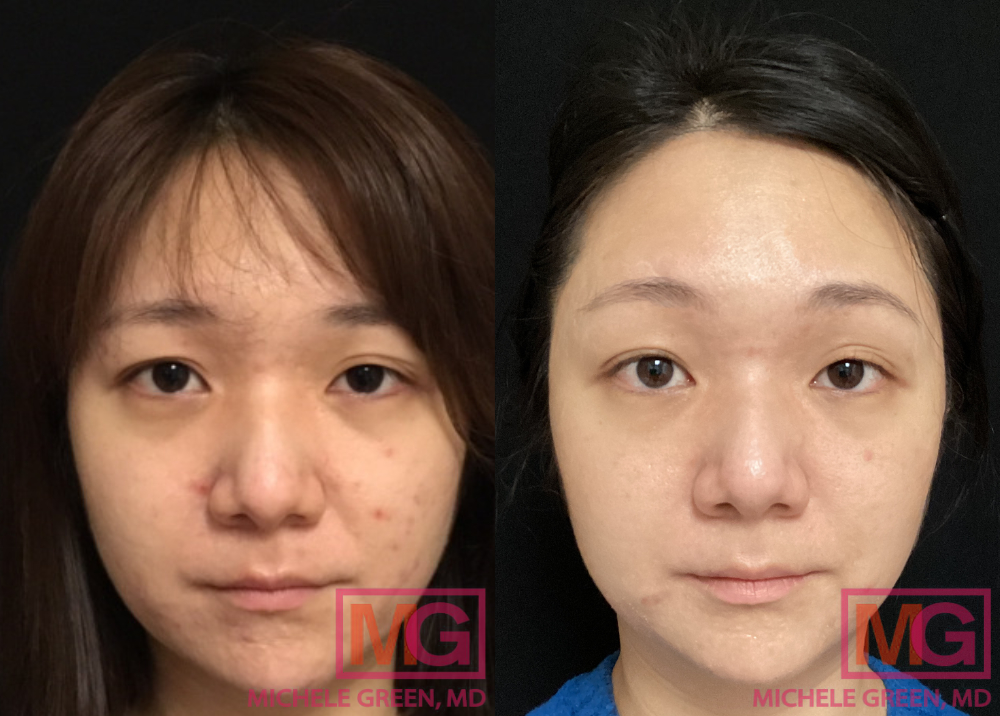
Effective skincare routines for acne-prone skin types
In addition to in-office treatments and prescription medications, maintaining a proper skincare routine is vital for treating and managing acne breakouts. The first step in any skincare routine for acne-prone Asian skin is to use a cleanser to ensure your skin is free of debris. A cleanser should be used twice daily, in the morning and at night, to remove dirt, excess oil, makeup, dead skin cells, and bacteria from the skin’s surface. Cleansers that are specifically non-comedogenic, non-acnegenic, oil-free, fragrance-free, and non-irritating are effective at reducing acne breakouts. The Pore Minimizing Cleanser from Dr. Green’s proprietary skincare line, MGSKINLABs, is an excellent product for acne-prone skin. Its formulation contains both salicylic acid and glycolic acid to gently exfoliate the skin and clear clogged pores. Patients sensitive to glycolic or salicylic acid can use the Gentle Cleanser from MGSKINLABs to gently clean their skin without stripping it of its natural moisture.
Another important step in your skincare routine is using toner, which is often less discussed than cleansers and moisturizers. Toners are applied after cleansing to hydrate the face and prepare the pores for additional treatments, serums, or sheet masks, helping improve nutrient and treatment absorption into the skin. Various types of toners work well for different skin types. For those with oily skin, a toner containing ingredients such as salicylic acid and witch hazel can effectively cleanse the face without drying it out. The Retexturizing Pads from MGSKINLABs include both salicylic and glycolic acids to further cleanse the skin and remove pore buildup. For sensitive skin, a gentle toner like MGSKINLAB’s Gentle Toner is a great choice to neutralize excess oil and unclog pores.
Retinol is a great over-the-counter skincare option for people with oily or acne-prone skin. Retinols are vitamin A derivatives that help speed up skin cell turnover, gently removing dead skin cells and excess oil from the skin’s surface to prevent clogged pores. Retinol should only be used at night, along with proper sun protection, because it can increase skin sensitivity to sunlight. The Essential Antioxidant Infusion from MGSKINLABS is a potent retinol supplement that contains vitamin A and other essential vitamins and nutrients to promote skin cell renewal and nourish the skin.
Another effective acne-fighting ingredient is benzoyl peroxide, an antibacterial agent that kills acne-causing bacteria on the skin’s surface. Benzoyl peroxide is found in various face washes and treatments. The Acne Spot Treatment from MGSKINLABs contains 10% benzoyl peroxide to inhibit bacterial growth, reduce inflammation, and dry out acne lesions. Patients with oily or acne-prone skin should also use a moisturizer daily to nourish the skin and prevent dryness, which can lead to increased sebum production. Moisturizers should be oil-free and non-comedogenic, meaning they do not clog pores. MGSKINLAB’s Ultimately Sheer Lotion is a lightweight, oil-free moisturizer ideal for sensitive, oily, or acne-prone skin.
Finally, all patients should wear sunscreen daily to protect against the harmful effects of UV rays. A broad-spectrum sunscreen with an SPF of at least 50 should be used for full protection. The Hydrating SPF 50 from MGSKINLABs contains zinc oxide to shield from sun damage, along with hyaluronic acid and lactic acid to hydrate and soften the skin.
Is salicylic acid (BHA) good for Asian skin?
Yes! Salicylic acid is a beta-hydroxy acid (BHA) that penetrates pores to soften and exfoliate dead skin cells, sebum, dirt, sweat, and other impurities. Salicylic acid is one of the best over-the-counter ingredients for fighting acne and is found in various skincare products. The MGSKINLABs line uses salicylic acid in its Pore Minimizing Cleanser and Retexturizing Pads to gently exfoliate oily or acne-prone skin. These products are also formulated with glycolic acid, an alpha-hydroxy acid (AHA), to provide a deeper cleanse.
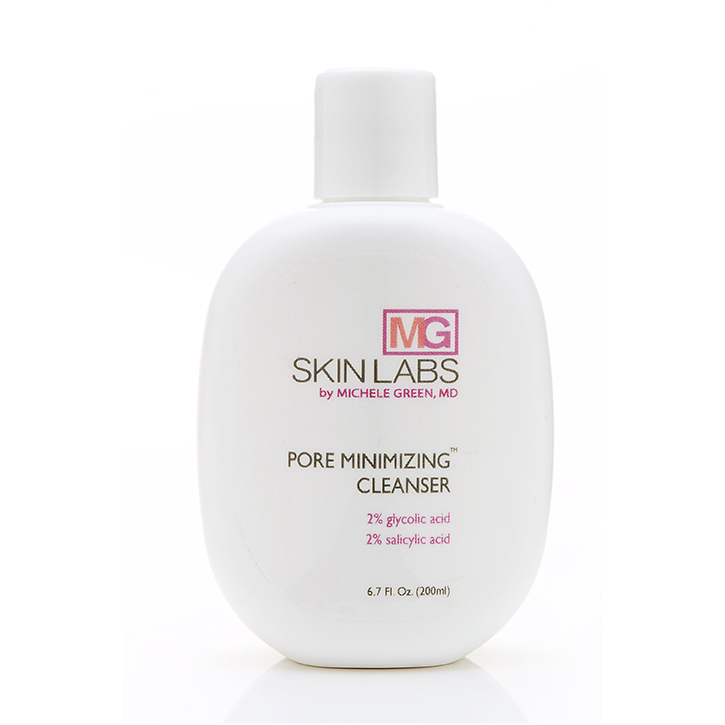
How do Koreans keep their skin acne-free?
Korean skincare products for acne usually feature gentle, hydrating formulas that include ingredients like tea tree oil and niacinamide, which are used daily to achieve and maintain clear, healthy, and radiant skin. Typically, acne treatment is part of the 10-step K-Beauty skincare routine and is applied after toner. Acne treatments for Asian skin can be purchased online from Korea-based K-beauty companies. However, the Korean skincare routine can also be followed with products available in the United States. The best approach is to consult with an expert dermatologist, such as Dr. Green, who can examine the treatment area and determine the most effective treatment plan for you.
What do Koreans use to treat acne?
Korean skincare emphasizes a 10-step routine to achieve and maintain clear, bright, glowing, healthy, and youthful-looking skin. The ten steps of the routine are as follows:
1) Oil-based Cleanser
An oil-based cleanser is a lightweight product that helps dissolve makeup, sunscreen, and other oil-based skincare items. Common ingredients include jojoba oil, argan oil, and rice bran oil.
2) Water-based Cleanser
The oil-based cleanser is followed by a water-based cleanser to remove any remaining dead skin cells, dirt, sweat, and other debris left on the skin. Double cleansing ensures the skin is as clean as possible and helps prevent pores from clogging.
3) Exfoliation
An exfoliator is a product, either physical or chemical, used to remove dead skin cells from the surface. These products can be applied once or twice a week to refresh the skin and reveal healthy, bright skin cells. Physical exfoliants contain abrasive ingredients, such as sugar or tiny beads, to gently scrub the skin. In contrast, chemical exfoliants utilize solutions such as beta-hydroxy acids (BHAs), alpha-hydroxy acids (AHAs), and polyhydroxy acids (PHAs) to remove impurities effectively.
4) Toner
A toner helps repair the natural skin barrier and prepares the pores to absorb topical treatments and serums. Toners differ in consistency and formulation and should be selected based on skin type, tone, and concerns.
5) Essence
An essence is a lightweight skincare product typically containing hydrating or anti-aging ingredients. Most Korean essences include rice extract or hyaluronic acid to nourish and deeply moisturize the skin.
6) Boosters, Treatments, & Serums
The sixth step of the 10-step Korean skincare routine varies the most between individuals. Boosters, treatments, and serums can be selected to address specific skin concerns, such as acne, dryness, anti-aging, hyperpigmentation, and uneven texture. These products often contain a high concentration of active ingredients to maximize benefits for the skin.
7) Sheet Masks
Sheet masks are a distinctive and essential part of Korean skincare routines. They help deliver a concentrated dose of active ingredients to the skin. Similar to step 6, sheet masks can be customized to target dry skin, discoloration, and irritation. Additionally, some sheet masks can be worn overnight for maximum hydration and ingredient absorption.
8) Eye Creams
Eye creams differ from typical moisturizers because they are specifically designed to target the delicate, thin skin under the eyes. These creams are used to prevent signs of aging like fine lines and wrinkles, reduce puffiness, and improve moisture retention.
9) Moisturizers
Moisturizers are essential in Korean skincare routines and any skincare regimen. They come in various forms, such as creams, gels, and masks, and help lock in moisture to keep skin hydrated.
10) Sunscreen
Sunscreen is the most crucial step in the Korean skincare routine, as proper sun protection is essential for preventing skin damage, including hyperpigmentation and sunspots. The sun’s UV rays are also a major cause of premature aging, as they can dry out the skin and make fine lines and wrinkles more noticeable. In addition to an SPF rating, Korean sunscreens typically have a PA rating, indicating the level of protection against UVA rays.
What are popular K-Beauty brands for Korean skincare products?
There are many excellent Korean skincare lines available today. Popular K-Beauty brands include COSRX, Mediheal, Innisfree, Laneige, and Beauty of Joseon. These brands offer a wide variety of cleansers, exfoliators, toners, essences, serums, moisturizers, and sunscreens to address different skin types and concerns. A common trait among most K-Beauty brands is their focus on hydrating, gentle skincare products that gradually nourish the skin.
What is the Asian treatment for acne and oily skin?
Unlike typical Western treatments for acne and oily skin, Asian therapies focus on gentle, sensitive ingredients that emphasize proper cleansing, hydration, and calming the skin. One of the most popular ingredients in Asian skincare today is cica, also known as Centella asiatica. This anti-inflammatory compound helps reduce inflammation, eliminate redness, and restore the skin’s natural moisture barrier. While Western treatments generally use beta and alpha hydroxy acids to exfoliate the skin, Asian treatments often employ polyhydroxy acids, which are typically milder on the skin. Snail mucin is another popular Asian skincare ingredient that aims to repair the skin’s moisture barrier and provide deep hydration.
Does all acne result in acne scarring?
Acne scars result from inflammatory acne and can appear as blemishes on the skin long after the initial breakout has faded. Any inflammatory acne can lead to scar formation. Atrophic acne scars form when inflammatory acne damages the skin, and the body cannot produce enough collagen during healing, creating depressions on the skin’s surface. These scars may appear as rolling scars, boxcar scars, or ice-pick scars. Hypertrophic scars are raised and occur due to excessive collagen production during healing. They can be the same size as the original lesion or develop into raised scars known as keloids. Post-inflammatory hyperpigmentation or discoloration may also occur at the breakout site, although it is not usually classified as a true scar. Asian skin tends to be more prone to hyperpigmentation than Caucasian skin because of higher levels of melanin.
Do acne scars go away?
While post-inflammatory hyperpigmentation may fade over time, acne scars cause permanent damage to skin tissue and do not heal on their own. Fortunately, several non-invasive treatments can significantly reduce their appearance. The first step in eliminating acne scars for Asian skin is to find a dermatologist who specializes in treating Asian skin and skin of color, such as Dr. Green. During your initial consultation with Dr. Green, she will examine the treatment area to determine the most appropriate treatment or series of treatments for your needs. The exact treatment depends on the type of acne scar and your skin type, as some laser treatments and chemical peels may not be safe for patients with Asian skin. Many options available at Dr. Green’s office are safe and effective for patients of Asian descent, including laser treatments like VBeam and eMatrix, chemical peels, and dermal fillers.
Non-invasive cosmetic procedures for acne scar treatment in Asian skin
VBeam laser
The VBeam laser is a pulsed dye laser that helps eliminate redness and pigmentation associated with skin issues such as acne scars, hyperpigmentation, and rosacea. It is a non-ablative laser, meaning there is no downtime, and it is often regarded as the gold standard for treating redness and discoloration on the skin. Multiple sessions are required, each spaced one month apart, to diminish the appearance of red acne scars or post-inflammatory hyperpigmentation.
eMatrix laser
The eMatrix Sublative laser is a resurfacing treatment that minimizes the appearance of acne scars, fine lines, wrinkles, and uneven skin texture. Often referred to as a ‘color-blind’ laser, it is safe and effective for all skin types, including those with Asian skin. This laser uses bipolar radiofrequency energy to heat the dermal layer of the skin in the treated area, stimulating collagen production and skin cell renewal to enhance skin texture. Patients typically require three to five sessions, spaced one month apart, to achieve the best cosmetic results.
Subcision with dermal fillers
Subcision is a minimally invasive cosmetic procedure that reduces the appearance of atrophic or depressed acne scars. During the procedure, a small needle is used to break the tissue that tethers the acne scar to the skin’s surface. Dr. Green consistently combines subcision with dermal fillers to restore volume to the depressed area and smooth the skin. Common dermal fillers used for treating acne scars include Juvederm, Restylane, and Sculptra. Juvederm and Restylane are made of hyaluronic acid, which provides immediate volume and lasts from nine to twelve months, depending on the specific filler. Sculptra contains poly-L-lactic acid, a substance that stimulates new collagen growth, with results lasting up to two years after a series of treatments.
Chemical peels
Chemical peels are treatments that use acids to enhance the skin by exfoliating and rejuvenating it. The acid interacts with dead skin cells and debris on the surface, causing them to slough off and boosting the production of new skin cells, which results in a more even skin tone and smoother texture. Multiple sessions are usually necessary to achieve optimal results. When choosing a chemical peel, it is important to consult with a board-certified dermatologist, as not all peels are safe for Asian skin. Depending on your skin tone and type, Dr. Green might recommend a different chemical peel to address your acne scars.
Mesopeels
Mesopeels are specially formulated chemical peels designed to treat hyperpigmentation, including post-inflammatory hyperpigmentation from old acne scars. Mesopeels contain skin-lightening ingredients like kojic acid, tranexamic acid, and azelaic acid to brighten the skin, lessen discoloration, and create a more even skin tone. They are safe and effective for patients of all skin types and tones, making them a great choice for treating hyperpigmentation. Typically, four to six Mesopeel treatments are needed to eliminate post-inflammatory hyperpigmentation.
Microneedling
Microneedling is a non-invasive cosmetic treatment that targets various skin concerns, including acne scars, fine lines, wrinkles, uneven texture, discoloration, and enlarged pores. Often called “collagen induction therapy,” microneedling uses tiny, medical-grade needles to create microscopic channels in the skin, which activate the body’s natural healing process and stimulate new collagen production. Collagen is a protein that gives skin its structure. By increasing collagen, microneedling can lead to smoother, firmer skin and noticeable rejuvenation. Patients usually need at least three sessions, spaced one month apart, to achieve optimal results.
One key benefit of microneedling is that the tiny channels it creates improve the absorption of topical serums or products. Dr. Green can apply a depigmentation serum during the procedure for patients with post-inflammatory hyperpigmentation and dark spots from previous acne. This serum contains a unique blend of potent yet gentle skin-brightening agents that inhibit and block melanocyte activity in the skin.
Patients can also use platelet-rich plasma (PRP) for enhanced rejuvenation. PRP is derived from a blood sample and contains epidermal growth factors that promote regeneration and healing at the cellular level, enhancing the results of microneedling. Since the PRP serum comes from the patient’s own blood, it is safe for all skin types and tones.
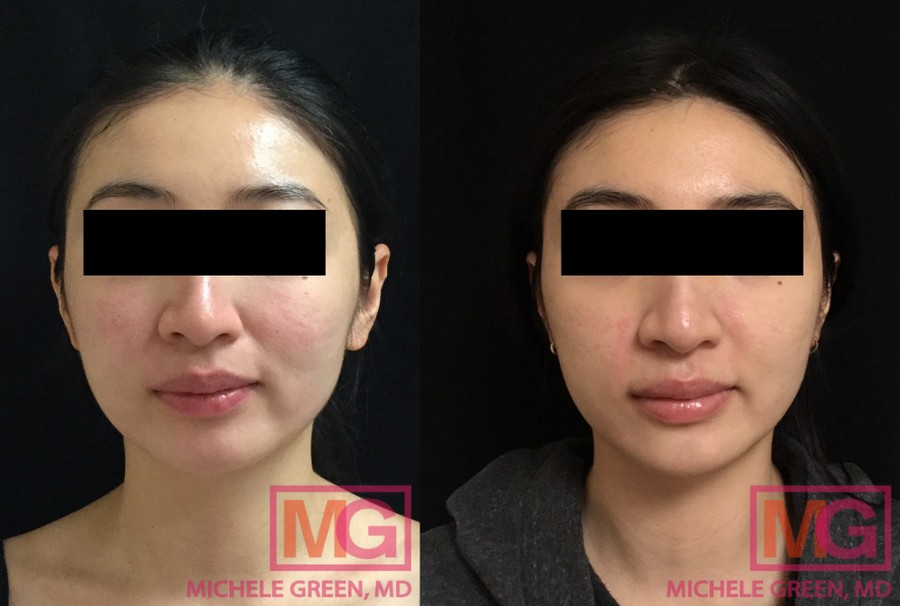
How do Asians have clear skin without dark spots from old acne?
The best skincare products for reducing dark spots and post-inflammatory hyperpigmentation contain proven skin-lightening ingredients. One of the top ingredients for treating hyperpigmentation is vitamin C, a powerful antioxidant that helps diminish dark spots and protects the skin from free radical damage. The Vita-C Serum from MGSKINLABs features a high concentration of vitamin C to boost skin cell turnover and brighten the skin for a radiant, more even complexion. Other common ingredients for skin lightening include tranexamic acid, kojic acid, azelaic acid, and glycolic acid. The Skin Brightening Cream from MGSKINLABs contains a unique blend of kojic acid and fruit extracts, designed to lighten dark spots and gradually rejuvenate the skin.
In certain cases, Dr. Green may recommend hydroquinone, a prescription topical cream. Hydroquinone is a potent lightening agent that helps reduce melanin or pigment production in the affected area, aiding in the fading of dark spots. It should not be used long-term and must only be applied under the supervision of a board-certified dermatologist, such as Dr. Green.
How do I get started with acne and acne scar treatment today?
Although acne is very common, its appearance on the face can lead to frustration and a decrease in self-esteem. Untreated acne can cause permanent skin damage, resulting in scars that may be even harder to treat than the initial breakout. Fortunately, expert board-certified dermatologist Dr. Michele Green offers a variety of treatment options at her Upper East Side office in New York City, serving patients of all skin tones and types. Dr. Green often uses a combination of in-office procedures, oral medications, and topical creams to control acne breakouts and help maintain clear skin. If acne scars develop, Dr. Green has several non-invasive cosmetic treatments, including lasers, dermal fillers, and chemical peels, which are safe and effective for patients with Asian skin. Whether you’re dealing with active acne or scars, Dr. Green is here to help.
Dr. Michele Green is a globally acclaimed, board-certified dermatologist with over 25 years of experience in providing premium treatments for the world’s most selective individuals, including those dealing with acne breakouts and scars. She is regularly recognized as one of New York City’s top dermatologists by Castle Connolly, New York Magazine, Super Doctors, and The New York Times for her dedication and expertise. When you consult with Dr. Green at her private dermatology practice in Manhattan’s Upper East Side, she will collaborate with you to create a personalized treatment plan that matches your skin tone, specific concerns, skin type, and aesthetic goals. To lessen the appearance of acne scars and identify the most effective treatment protocol for collagen regeneration, discoloration reduction, and achieving smooth, clear skin, book a consultation by contacting Dr. Green online or calling our New York City office at 212-535-3088.
 212-535-3088
212-535-3088